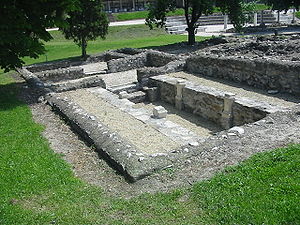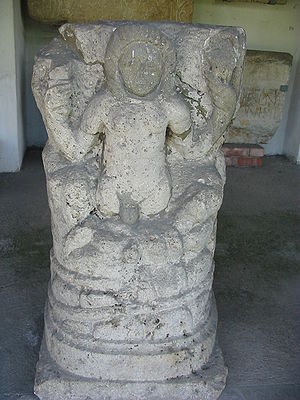.gif)
Aquincum Mithraeum (of Victorinus)
Encyclopedia

Mithraeum
A Mithraeum is a place of worship for the followers of the mystery religion of Mithraism.The Mithraeum was either an adapted natural cave or cavern or an artificial building imitating a cavern. Mithraea were dark and windowless, even if they were not actually in a subterranean space or in a natural...
) was built within a townhouse in the Roman city of Aquincum
Aquincum
The ancient city of Aquincum was situated on the North-Eastern borders of the Pannonia province within the Roman Empire. The ruins of the city can be found today in Budapest, the capital city of Hungary...
, on the outskirts of the modern city of Budapest
Budapest
Budapest is the capital of Hungary. As the largest city of Hungary, it is the country's principal political, cultural, commercial, industrial, and transportation centre. In 2011, Budapest had 1,733,685 inhabitants, down from its 1989 peak of 2,113,645 due to suburbanization. The Budapest Commuter...
, Hungary
Hungary
Hungary , officially the Republic of Hungary , is a landlocked country in Central Europe. It is situated in the Carpathian Basin and is bordered by Slovakia to the north, Ukraine and Romania to the east, Serbia and Croatia to the south, Slovenia to the southwest and Austria to the west. The...
.
The mithraeum.
The temple was discovered during excavations in 1888 within what appeared to be a large house near to the centre of the Roman city. Due to the size of the house and the importance of its location it must have belonged to an important individual and this must certainly be the decurionDecurion (administrative)
A decurion was a member of a city senate in the Roman Empire. Decurions were drawn from the curiales class, which was made up of the wealthy middle class citizens of a town society....
Marcus Antonius Victorinus who dedicated a number of small altars within the sanctuary.
The shrine was orientated north to south and measured 7m wide by 15.03m long. The interior was divided up into three parts- two ante rooms and the sanctuary proper. The front room (Room A: 4.75 x 2.90m)is postulated by the excavators as a Shrine of Mercury
Mercury (mythology)
Mercury was a messenger who wore winged sandals, and a god of trade, the son of Maia Maiestas and Jupiter in Roman mythology. His name is related to the Latin word merx , mercari , and merces...
. A room (Room B: 0.85x2.90m) was located on the west side and is of uncertain purpose. The middle room (Room C: 5.90x3m) probably served as a narthex
Narthex
The narthex of a church is the entrance or lobby area, located at the end of the nave, at the far end from the church's main altar. Traditionally the narthex was a part of the church building, but was not considered part of the church proper...
. The main part of the shrine was divided into three lateral parts, typical of all mithraea. A central nave
Nave
In Romanesque and Gothic Christian abbey, cathedral basilica and church architecture, the nave is the central approach to the high altar, the main body of the church. "Nave" was probably suggested by the keel shape of its vaulting...
about 2.18m wide and 1 meter below ground level was flanked on either side by podium benches for the initiates to recline on during the ceremonies (see Mithraic worship). Steps lead down to the lower floor level of the nave
Nave
In Romanesque and Gothic Christian abbey, cathedral basilica and church architecture, the nave is the central approach to the high altar, the main body of the church. "Nave" was probably suggested by the keel shape of its vaulting...
directly from the entrance and the higher benches were accessed by single steps on either side of the bottom nave step. Along the front of the benches, and slightly recessed into them, were placed a pair of small altars (H 0.65 Br. 0.30m) all dedicated by Marcus Antoninus Victorinus.
Sculptural and epigraphic evidence.

- Limestone relief (H 0.98. Br 0.55m) depicting Mithras' rockbirth. Mithras, naked and emerging from the rock to mid-thigh, holds a burning torch in his upraised left hand and a dagger in his right. The rock is encircled by a serpant who raises its head towards the god.
- DEO CAUTI / M ANT(onius) VIC/TORINUS / DEC(urio) COL(oniae) / AQ(uninci) AEDILIS.
To Cautes (see Cautes and Cautopates
Cautes and Cautopates
Cautes and Cautopates are torch-bearers depicted attending the god Mithras in the icons of ancient Roman cult of Mithraism. Cautes holds his torch raised up, and Cautopates holds his torch downward.-Interpretation:...
). Marcus Antonius Victorinus, Decurion of the colony of Aquincum. Aedile
Aedile
Aedile was an office of the Roman Republic. Based in Rome, the aediles were responsible for maintenance of public buildings and regulation of public festivals. They also had powers to enforce public order. There were two pairs of aediles. Two aediles were from the ranks of plebeians and the other...
.
- As above though to DEO CAU/TOPATI / To Cautopates... (See Cautes and CautopatesCautes and CautopatesCautes and Cautopates are torch-bearers depicted attending the god Mithras in the icons of ancient Roman cult of Mithraism. Cautes holds his torch raised up, and Cautopates holds his torch downward.-Interpretation:...
).
- FONTI / PERENNI / M ANT(onius) / VICTORI/NUS DEC(urio) / COL(oniae) AQ(uinci) / AED(ilis).
To the lasting spring. Marcus Antonius Victorinus, Decurion of the colony of Aquincum. Aedile
Aedile
Aedile was an office of the Roman Republic. Based in Rome, the aediles were responsible for maintenance of public buildings and regulation of public festivals. They also had powers to enforce public order. There were two pairs of aediles. Two aediles were from the ranks of plebeians and the other...
.
- {....DE]C(urio) / COL(oniae) AQ(uinici) AED(ilis).
- A fragment of the tauroctonyTauroctonyThe tauroctony scene is the cult relief of the Mithraic Mysteries. It depicts Mithras killing a bull, hence the name 'tauroctony', given to the scene in modern times possibly after the Greek ταυροκτόνος "slaughtering bulls", which derives from ταῦρος "bull" + κτόνος "murder", from κτείνω , "I...
(the main cult image) was found in the excavations and would have stood on the large stone base at the end (south) wall of the temple cellaCellaA cella or naos , is the inner chamber of a temple in classical architecture, or a shop facing the street in domestic Roman architecture...
.
The mithraeum today
The shrine is fully accessible within the AquincumAquincum
The ancient city of Aquincum was situated on the North-Eastern borders of the Pannonia province within the Roman Empire. The ruins of the city can be found today in Budapest, the capital city of Hungary...
Archaeological Park, just south of the Aquincum Museum
Aquincum Museum
The Aquincum Museum is a museum in Budapest, Hungary, Szentendrei út 135. Archeological findings from the remains of Aquincum are on display there. These include items from the local Mithraeum. It has an indoor and outdoor part.-External links:*...
building. The remains have been heavily restored and consolidated for display.
The tauroctony
Tauroctony
The tauroctony scene is the cult relief of the Mithraic Mysteries. It depicts Mithras killing a bull, hence the name 'tauroctony', given to the scene in modern times possibly after the Greek ταυροκτόνος "slaughtering bulls", which derives from ταῦρος "bull" + κτόνος "murder", from κτείνω , "I...
fragment and the altar are located in the eastern wing of the Lapidarium
Lapidarium
A lapidarium is a place where stone monuments and fragments of archaeological interest are exhibited - stone epigraphs, statues, architectural details like columns, cornices and acroterions, as well as tombstones and sarcophagi....
situated at the northern edge of the Archaeological Park. The Victorinus altars are the originals in situ.
See also
- Fertorakos MithraeumFertorakos mithraeumThe Fertorakos Mithraeum is a temple to the Roman god Mithras at Fertőrákos in Hungary. The temple , follows a typical plan of a narthex followed by the shrine proper that consists of a sunken central nave with podium benches on either side.- Discovery :It was discovered by chance by a stonemason...
: Mithraeu in Fertőrákos, Hungary - Savaria MithraeumSavaria MithraeumSavaria Mithraeum was the shrine of Mithras in the Roman town of Savaria which was discovered in 2008.-History:The cult of Mithras was popular in the Roman province of Pannonia...
: Mithraeum in Savaria, Hungary

